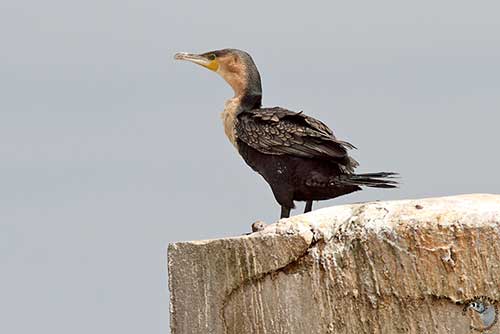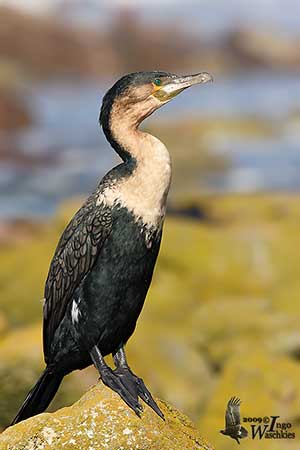
Fr: Cormoran à poitrine blanche
Ang: White-breasted Cormorant
All: Weissbrustkormoran
Esp: Cormorán grande
Ita: Cormorano pettobianco
Nd: Witborstaalscholver
Photographers:
Didier Buysse
Vision d’Oiseaux
Callie de Wet
GALLERY
Ingo Waschkies
My bird pictures on Pbase
Text by Nicole Bouglouan
Sources:
HANDBOOK OF THE BIRDS OF THE WORLD vol 1 by Josep del Hoyo-Andrew Elliot-Jordi Sargatal - Lynx Edicions - ISBN: 8487334105
BIRDS OF AFRICA SOUTH OF THE SAHARA by Ian Sinclair and Peter Ryan - Princeton University Press Princeton and Oxford - ISBN: 0691118159
BIRDS OF THE GAMBIA AND SENEGAL by Clive Barlow and Tim Wacher – Helm Field guides – ISBN: 0713675497
Wikipedia, the free encyclopaedia
White-breasted Cormorant
Phalacrocorax lucidus
Suliformes Order – Phalacrocoracidae Family
INTRODUCTION:
The White-breasted Cormorant was formerly a subspecies of the Great Cormorant (P. carbo), and some authors still consider it as a subspecies.
Cormorants are more correctly known as waterbirds than seabirds, because they are rarely seen out to sea. They frequent mainly the shorelines of a variety of marine, brackish and fresh water.
The White-breasted Cormorant differs from P. carbo by the white underparts contrasting strongly with the dark upperparts. It is largely sedentary in its African range.

DESCRIPTION OF THE BIRD:
Biometrics:
Length: 80-100 cm
Wingspan: 120-150 cm
Weight: M: 3100 g – F: 1800 g
The White-breasted Cormorant adult has glossy dark brown plumage, except the white patch of the thigh, and the white cheeks, foreneck and breast. On the upperwing, the feathers are broadly edged pale buff, creating a scaled effect.
On the head, forehead, crown, nape and hindneck are dark brown, with shaggy feathers on the hindneck. The bare skin of the face is yellow on cere, lores and chin, and there is a yellow orbital ring around the turquoise-green eyes. The long, slender bill is grey with slightly paler lower mandible, and upper mandible sharply curved at tip. Legs and large webbed feet are blackish.
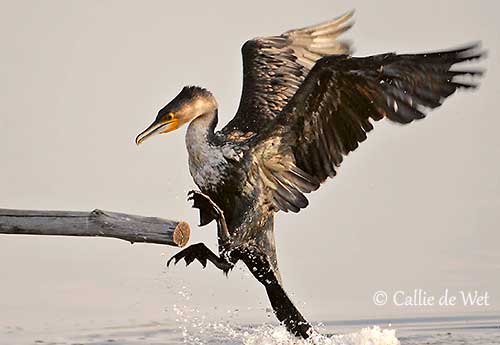
Male and female are similar. They are slightly duller outside breeding.
The juvenile is paler than adults with entirely white underparts.
The immature is duller above and greyer below.
RANGE:
The White-breasted Cormorant is found in sub-Saharan Africa, including coastal W and S Africa from Cape Verde Islands to Guinea-Bissau, and from Angola to the Cape of Good Hope, and N on the E coast of Mozambique. It is also found inland in E Africa. Some inland populations occur in Nigeria and around Lake Chad, and from Sudan southwards to E and S Africa.
HABITAT:
The White-breasted Cormorant usually prefers open water including saline, brackish and fresh water. It frequents shallow water near the shores in the ocean, whereas inland, it can be found around lakes, dams and rivers with abundant fish. It also frequents estuaries and deltas, mangrove swamps, coastal lagoons and bays.
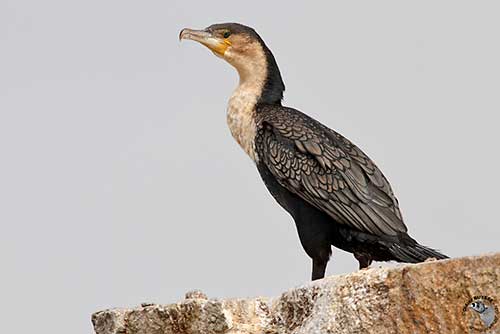
CALLS AND SONGS: SOUNDS BY XENO-CANTO
The White-breasted Cormorant is usually silent, but at colonies and near the nest, it produces grunts, growls, squeals and hisses.
BEHAVIOUR IN THE WILD:
The White-breasted Cormorant feeds on fish, crustaceans and occasionally molluscs. It swims and dives to a depth of about ten metres. It pursues the prey by swimming underwater, grabs it in the bill and usually swallows it immediately depending on the size. The larger preys are brought back to the shore to be eaten.
Other preys such as crustaceans, amphibians and molluscs are snapped up rapidly.
The White-breasted Cormorant is often seen perched erect in open, often on exposed perches. It is both solitary and gregarious according to the season.
It usually breeds in mixed-species colonies and often returns at sites and nests of the previous years. The male selects and defends the nest-site and later, it tries to attract females. Courtship displays include wing-waving motion, in order to expose the white thigh patches, showing and hiding them as the wings are moving.
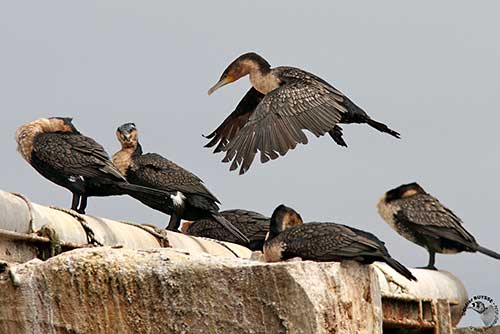
Once the pair is formed, the pair-bond is strengthened by mutual preening, gurgling with head held upwards, and entwining the necks. They are monogamous, but most birds change partners every year.
The White-breasted Cormorant is largely sedentary in its range, only performing some movements related to the changes in water levels.
It has powerful flight, often low over water. Head and neck are outstretched during the flight.
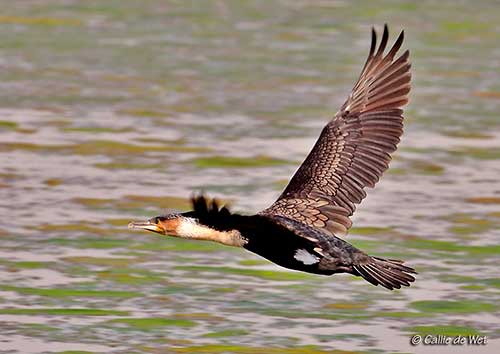
REPRODUCTION OF THIS SPECIES:
The breeding season is year-round, with peak between September and December in the Western Cape, and between January and July elsewhere.
The White-breasted Cormorant breeds in colonies, usually less than 50 pairs, although colonies have been recorded with several hundreds of pairs including darters, spoonbills and herons.
The male collects nest material, but the nest is built by the female, a flat platform made with sticks, twigs and feathers, occasionally with debris and seaweeds. It is rapidly covered in guano, and is often reused in several following years.
It is placed on island, cliff-ledges, offshore rocks, shipwreck, pylon and other man-made structures.
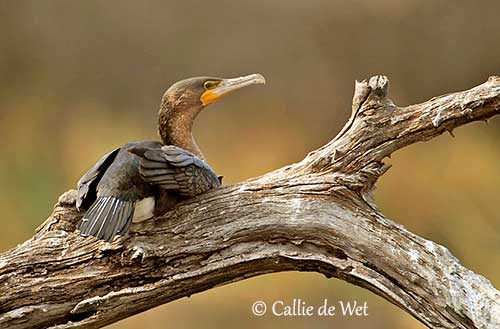
The female lays 3-4 eggs and both adults incubate during 28-30 days with stints of six hours involving displays at changeover. The eggs are incubated between the large webbed feet and the belly feathers.
The chicks are naked at hatching, but a black down is growing quickly. They are fed by both parents by regurgitated food. The weakest chicks often die quickly, and the strongest young are able to defend themselves against predators by swaying the head and lunging repeatedly.
They fledge about 50 days after hatching and can fly 10 days later. They are still fed by parents for six weeks more.
The main threats for the juveniles are predation, starvation and falling from cliffs.
PROTECTION / THREATS / STATUS:
The White-breasted Cormorant is threatened by disturbance on the breeding grounds, feral dogs, fishing lines at sea, oil pollution, diseases and fishermen who kill the cormorants as their consider them competitors.
The population has not been quantified, but the White-breasted Cormorant is listed as Endangered in some parts of the range, but it is not globally threatened.
This species is still considered a subspecies of P. carbo by BirdLife International and IUCN, and its status as full species are not available.
